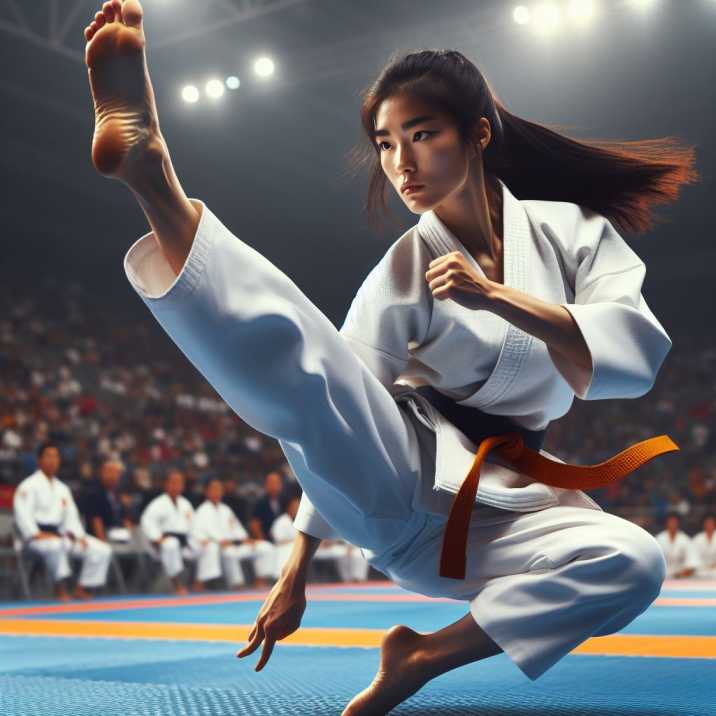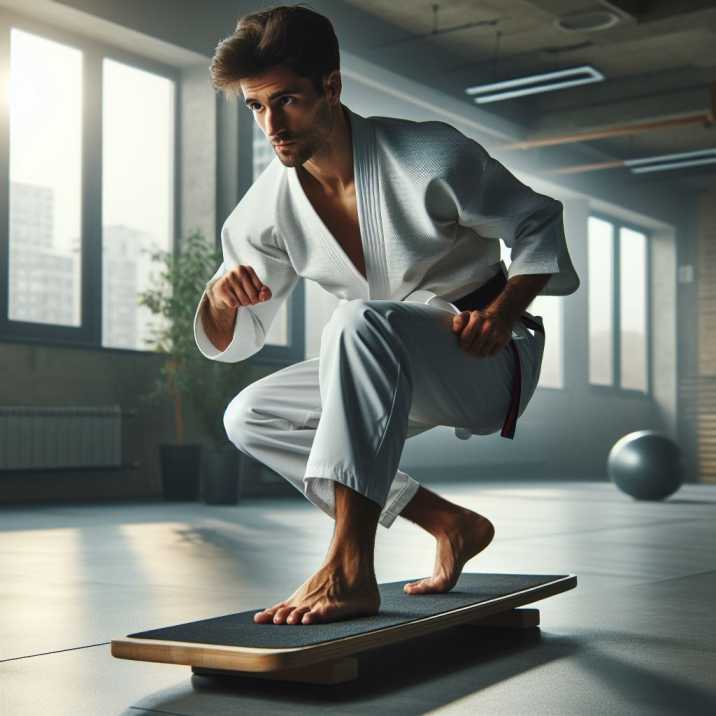Introduction:
Table of Contents
Balancing Boards and Their Impact on Footwork in Martial Arts
Balancing Boards and Their Impact on Footwork in Martial Arts are essential tools for any martial artist looking to enhance their skills. These boards offer a unique way to improve balance, stability, and coordination, ultimately leading to better footwork and technique in various martial arts disciplines.

Understanding the Importance of Balance in Martial Arts
Balancing boards and their impact on footwork in martial arts is the foundation of martial arts, dictating movement, stability, and control. Without proper balance, executing techniques effectively becomes challenging. Balancing boards provide an excellent platform to develop and refine this crucial skill.
Benefits of Using Balancing Boards in Martial Arts Training
Balancing boards offer a multitude of benefits, including improved core strength, proprioception, and spatial awareness. By incorporating these boards into your training regimen, you can enhance your overall performance and minimize the risk of injuries.
Types of Balancing Boards Suitable for Martial Arts
There are various types of balancing boards available, each catering to different skill levels and training objectives. From basic rocker boards to more advanced wobble boards and balance pads, choosing the right board depends on your specific needs and goals.
Techniques for Effective Use of Balancing Boards
To maximize the benefits of balancing boards, proper technique is essential. This includes maintaining a neutral stance, engaging the core muscles, and focusing on controlled movements. Practicing a variety of exercises, such as squats, lunges, and single-leg balances, can also improve balance and footwork.
Integrating Balancing Board Drills into Martial Arts Training
Incorporating balancing board drills into your martial arts training routine can significantly enhance your footwork and overall performance. These drills can simulate real-life scenarios, such as shifting weight during strikes or evading opponents, allowing you to develop practical skills that translate directly to the martial arts arena.
Common Mistakes to Avoid When Using Balancing Boards
While balancing boards can be highly beneficial, improper use can lead to potential pitfalls. Common mistakes include relying too heavily on hand support, neglecting proper form, and overexerting oneself. By being mindful of these pitfalls, you can maximize the effectiveness of your balancing board workouts.
Progression and Advanced Techniques with Balancing Boards
As you become more proficient with balancing boards, you can progress to more advanced techniques to further challenge your balance and footwork. This may include incorporating dynamic movements, increasing instability, or adding resistance to your exercises.
The Role of Balancing Boards in Injury Prevention
Maintaining proper balance is crucial for injury prevention in martial arts. By strengthening stabilizing muscles and improving proprioception through balancing board training, you can reduce the risk of common injuries such as sprains, strains, and falls.
Balancing Boards for Cross-Training in Martial Arts
Balancing boards are not only beneficial for traditional martial arts but also for cross-training purposes. They can complement other forms of training, such as strength and conditioning, flexibility, and agility drills, resulting in a well-rounded martial artist with superior footwork and balance.
Incorporating Balancing Boards into Martial Arts Classes
Martial arts instructors can integrate balancing boards into their classes to enhance students’ footwork and overall performance. By incorporating specific drills and exercises, instructors can help students develop better balance, stability, and coordination, ultimately improving their martial arts skills.
Balancing Boards for Rehabilitation and Recovery
In addition to training benefits, balancing boards and their impact on footwork in martial arts can also aid in rehabilitation and recovery from injuries. Physical therapists often incorporate balancing board exercises into rehabilitation programs to improve balance, strength, and mobility in patients recovering from orthopedic injuries or surgeries.
Balancing Boards in Martial Arts Competitions
Finally, balancing boards and their impact on footwork in martial arts competitions, particularly in disciplines that emphasize agility, speed, and precision footwork. Athletes who incorporate balancing board training into their preparation may gain a competitive edge, showcasing enhanced balance and control during their performances.

Tabe of Information
Below is a table summarizing the information about the images for your article on “Balancing Boards and Their Impact on Footwork in Martial Arts”:
| Image Title | Alt Text | Description |
|---|---|---|
| Balancing Board Basics | A martial artist using a balancing board to improve footwork | Discover the fundamentals of balancing board training for martial arts footwork. |
| Core Strengthening with Balancing Boards | A practitioner engaging their core muscles while using a balancing board | Learn how balancing boards can help strengthen your core muscles, essential for stability and control in martial arts. |
| Advanced Balancing Board Techniques | A martial artist performing advanced footwork drills on a balancing board | Explore advanced techniques and drills to challenge your balance and footwork using a balancing board. |
| Injury Prevention with Balancing Boards | A martial artist practicing balance exercises on a balancing board to prevent injuries | Discover how balancing boards can aid in injury prevention by improving balance, stability, and coordination in martial arts training. |
| Cross-Training Benefits of Balancing Boards | A martial artist incorporating balancing board training into their cross-training routine | Explore the benefits of using balancing boards for cross-training purposes, enhancing overall fitness and performance in martial arts. |
| Balancing Boards in Martial Arts Competitions | A martial artist showcasing enhanced balance and footwork during a competition | Learn how balancing board training can give you a competitive edge in martial arts competitions, improving agility, speed, and precision footwork. |
| Balancing Board Rehabilitation Exercises | A physical therapist guiding a patient through balancing board exercises for rehabilitation | Discover how balancing board exercises are used in rehabilitation programs to improve balance, strength, and mobility in patients recovering from orthopedic injuries or surgeries. |
These images and descriptions can be used to enhance your article and provide visual aids for better understanding of the concepts discussed.
Conclusion:
Balancing boards are invaluable tools for martial artists looking to improve their footwork and overall performance. By understanding their importance, utilizing proper techniques, and integrating them into training regimens, practitioners can enhance their balance, stability, and coordination, ultimately becoming more proficient martial artists.
In conclusion, balancing boards and their impact on footwork in martial arts an essential aspect of training for practitioners of all levels. By understanding the importance of balance, incorporating proper techniques, and integrating balancing board drills into training routines, martial artists can achieve heightened agility, stability, and control, ultimately leading to improved performance in their respective disciplines. Whether you’re a beginner looking to establish a solid foundation or an experienced practitioner striving to refine your skills, balancing boards offer a versatile and effective tool for enhancing footwork in martial arts.
FAQs:
- What are the benefits of using balancing boards in martial arts training?
- Balancing boards offer numerous benefits, including improved balance, stability, coordination, and core strength. They also help enhance proprioception and spatial awareness, which are crucial for effective footwork in martial arts.
- Are balancing boards suitable for beginners?
- Yes, balancing boards are suitable for practitioners of all levels, including beginners. They provide a safe and effective way to develop balance and stability, which are fundamental skills in martial arts. Beginners can start with basic exercises and gradually progress to more advanced techniques as they build confidence and proficiency.
- Can balancing boards help prevent injuries in martial arts?
- Yes, balancing boards can play a significant role in injury prevention in martial arts. By strengthening stabilizing muscles, improving proprioception, and enhancing overall balance and coordination, practitioners can reduce the risk of common injuries such as sprains, strains, and falls.
- How often should I incorporate balancing board drills into my training routine?
- The frequency of balancing board drills depends on individual goals, fitness levels, and training schedules. However, incorporating balancing board exercises 2-3 times per week, either as part of a warm-up or dedicated training session, can yield significant benefits in terms of improving footwork and overall performance in martial arts.
- Can balancing boards be used for rehabilitation purposes?
- Yes, balancing boards are commonly used in rehabilitation settings to aid in the recovery from orthopedic injuries or surgeries. Physical therapists often incorporate balancing board exercises into rehabilitation programs to improve balance, strength, and mobility in patients recovering from injuries related to the lower extremities. Always consult with a healthcare professional before starting any rehabilitation program involving balancing boards


